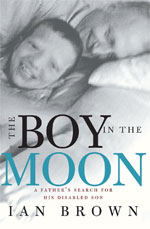I’m very excited to welcome my first guest blogger to the Bookgaga book blog – my 16-year-old niece H. Somewhat in the tradition of “Take Your Kids to Work Day”, I invited H to familiarize herself with book blogs, and to take a bit of a stretch beyond school book reports and try contributing some reviews herself. I selected the titles, and she very gamely read them, thought a lot about them and has put time and thought into her assessments.
Essex County
, by Jeff Lemire and The Boy in the Moon
, by Ian Brown are much touted and discussed books that I’ve read a lot about, am interested in … but have not yet read myself. I was curious as part of this exercise to see if H’s reviews would be consistent with other commentary and coverage, would bring some new ideas forth, and might possibly dissuade me on one count or the other. I can safely say that she has brought some fresh perspectives in, and while critical in places, her comments have further convinced me to keep both books on the tbr list.
I hope you’ll find H’s reviews and this new Bookgaga venture interesting and thought provoking.

Essex County, by Jeff Lemire
(Guest review by H)
I found the book
Essex County to be a light, easy-going story. It was a very relaxing book and I found it full of adventure, and writer Jeff Lemire used creativity, showing how all the characters share connections from their pasts which they don’t realize in the present.
You also watch the characters develop, building connections. I actually felt as excited reading a hockey game, with characters, Vince and Lou Lebeuf, as I would in an NHL arena.
The stories are made to be a light read, nothing really too dramatic or serious. I liked that it was portrayed as a comic book. It was a nice change of pace. I also found that seeing pictures makes it easier to create an attachment with each individual character and their situations.
The character I grew most attached to is Lou Lebeuf, who played for the Toronto Grizzlies with his brother Vince. The story shows Lou all grown up, and having difficulties. You then learn the past, and about regrets created between Vince and Lou, and the fates they cause.
This story I could see being for teenage or older audiences. The book is very mature, yet has a looser, easier edge.
Essex County was a delight to read from beginning to end, and I would recommend if you haven’t read it to do so.

The Boy in the Moon, by Ian Brown
(Guest review by H)
I found great disappointment in such a promising book, as
The Boy In the Moon by Ian Brown let me down.
After a quick skim of the cover the book looked as if it would be a heartfelt tale of a man who wanted to know his son through the disorders. But in my opinion the book lost its focus. The focus at some points seemed to be how Ian and his wife Johanna would like to know if son, Walker understands them. They want to know if Walker grasps how much they love them and the situation he is in. I think the book comes off as more of a complaint. Many times Ian would mention how no one would take Walker for a weekend, or how much work Walker is. He even became to view Walker as the reason his marriage with Johanna was beginning to hit the rocks.
It was also uncomfortable when they mentioned Walker’s sister, Haylee, and how they wanted to give her another “normal” sibling, since Walker wasn’t “normal”. Yes, I realize Walker is disabled, but I do not feel it is right to mention in a book that is dedicated to your child that he is not normal.
Ian Brown makes Walker come across as an inconvenience to him, Johanna and Haylee, instead of having Walker come across as a battle the family would fight. That is where I found the story really lost all meaning and heartfelt hopes.
The characters were also very hard to connect with. At first I could see Ian’s point of view in the marriage difficulties but he frustrated me how he would admit after taking the nanny, Olga home to her apartment he would head to strip clubs and bars behind Johanna’s back, even though he knew she needed him at home to help with Walker.
Johanna seems to have given up all hope on Walker, as it was mentioned in the book, her wanting another “normal” child sparked many fights between her and Ian. She also at one point admits she no longer feels like Walker’s mummy, and had she known he was disabled and would be so much work she would’ve had an abortion.
The overall story could have been more compressed. I found often information is being repeated such as how much work Walker is, and the tasks needed to keep him alive and well. I also found Brown uses a lot of big medical terms, that in all honesty I would’ve been clueless about had I not taken grade eleven Biology. I think it would’ve been a key aspect for him to have the meanings of those words, or at least have attempted a little more to clarify them for other readers than myself.
The last few pages I found though made up for some of the book’s shortcomings. The beginning caught my attention…but the twelve chapters between one and fourteen didn’t grasp the reader’s attention or build much of a foundation to cause a connection. The middle was a little jumpy and also, I would find myself losing interest and having difficulty digesting what I read. The book seemed less about Walker and more about Ian and the negative impacts of Walker.
But the last few pages show a side of Ian I would have enjoyed to see throughout the whole book. It showed the real father-son connection between Walker and Ian, and how yes, Walker in fact does know he is loved.






